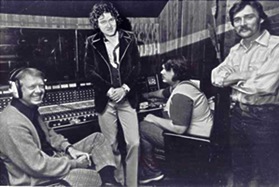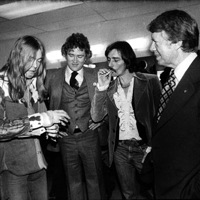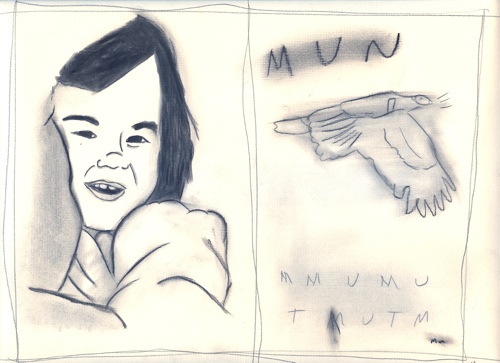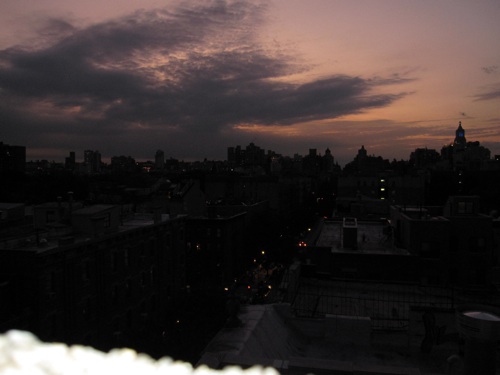
Photo by Dylan Spears
Peanuts… Jellybeans… MET-Rx Protein Bars…
by Joe Carducci
 The American political system proceeds according to a base-two system. Every two years the entire House of Representatives is up, plus one third of the Senate, and every other two-year period the Presidency is up. These overlapping bodies ratchet right or left and rarely line up to give either party a lock on Washington. It often seems the wisdom of the American crowd rarely tests out either party’s ideas without the hurdle of the other party tempering in counterpoint. But when the branches do align, politics manifests itself culturally in an unusually strong way. There is a superficial level of influence like increased sales of peanuts on Carter’s election, or jellybeans on Reagan’s, and then there is a level that normally proves too deep. Young voters and high schoolers excited about Barack Obama’s election can hardly be expected to acclaim any program of universal public service. This has been on the Democratic Party’s back burner since the Reagan era, but now that they have the power to pass it there may not even be a proposal. The idea tempts them because they see how Peace Corps and AmeriCorps volunteers vote. It seems a nice way to mint Democratic voters; it won’t be a simple military draft because that might mint Republicans
The American political system proceeds according to a base-two system. Every two years the entire House of Representatives is up, plus one third of the Senate, and every other two-year period the Presidency is up. These overlapping bodies ratchet right or left and rarely line up to give either party a lock on Washington. It often seems the wisdom of the American crowd rarely tests out either party’s ideas without the hurdle of the other party tempering in counterpoint. But when the branches do align, politics manifests itself culturally in an unusually strong way. There is a superficial level of influence like increased sales of peanuts on Carter’s election, or jellybeans on Reagan’s, and then there is a level that normally proves too deep. Young voters and high schoolers excited about Barack Obama’s election can hardly be expected to acclaim any program of universal public service. This has been on the Democratic Party’s back burner since the Reagan era, but now that they have the power to pass it there may not even be a proposal. The idea tempts them because they see how Peace Corps and AmeriCorps volunteers vote. It seems a nice way to mint Democratic voters; it won’t be a simple military draft because that might mint RepublicansNo, any real cultural response will manifest itself more in counter-formation to the new political zeitgeist.
The last time one party owned Washington was the middle four years of George W. Bush’s two terms. The time before that, the first two years of Bill Clinton’s administration. These periods didn’t do as much culturally as at first it seemed they might, although the political backfire in each case was loud and clear. Famously overheard during the Thunderbirds flyover at the Clinton inauguration were boos followed by actor Ron Silver’s protest to those booing that they were “our” planes now. Democrats in the Clinton administration and those in the majorities of Sen. George Mitchell’s Senate and Speaker Tom Foley’s House then duly struggled with their impulses and history over whether to use their planes to continue enforcing the Kurdish No-Fly zone in northern Iraq, or in Bosnia, in Kosovo, in Afghanistan, in Rwanda…. Before they knew it Newt Gingrich was Speaker and Sen. Bob Dole majority leader.
Bush’s first term was clouded by the disputed vote in Florida and then unnaturally jolted into unity by the 9-11 attacks; that unity gained his party the Senate but then the Republicans lost both houses at the six-year mark, leading to a fake trench warfare – fake because the war in Iraq was not stopped by the Democrats who still seemed spooked by the price the party paid over Vietnam. The party leaders judged that an immediate defunding and pull-out was the one thing that might turn the election the Republicans’ way. And for his part in this theater, Bush went along with the legislature with nary a veto until this last year of his second term. (9-11 did seem to permanently re-align Ron Silver, however.)
These two recent periods of single party alignment didn’t have staying power because the country’s demographics weren’t aligned as well. And for that to happen anytime after WWII, the baby boom had to be fully involved. The last time that happened Jimmy Carter was the political beneficiary. The voting age had been lowered to 18 for the 1972 presidential election (Nixon won that youth vote!), but until 1976 only the leading edge of the baby-boom was able to vote and its voting power didn’t fully register. Carter was a new face, governor of Georgia, and his religious faith brought in fellow evangelicals even while key early fund-raising support was provided by Georgia-based Capricorn Records and the Allman Brothers. He surprised the favored Democrats in Iowa and the primaries; they were seen to be too invested in the battles with Nixon (Frank Church), the failure in Vietnam (Hubert Humphrey), or hippie idealism (Jerry Brown). Carter promised a turn of the page on Ford, Nixon, Johnson, the Vietnam war, the hippies, the radicals, Watergate, the riots, the bombings, the assassinations, and he beat Gerald Ford. His presidency didn’t quite work out even so, and then Sen. Kennedy actually challenged a sitting president of his own party, softening him up for Ronald Reagan.
Reagan beat Carter, just after Margaret Thatcher replaced hapless Labour P.M.s James Callaghan and Harold Wilson in the UK. She truly altered the course of Britain, privatizing nationalized industries, pulling the state back until London became the world finance capitol it remains. Reagan never had Republican control of the House and Speaker Tip O’Neil fought him on domestic issues but supported the military build-up and the re-engaging of the cold war. But Reagan’s election, as a signal that the sixties ethos had hit the wall, was quite potent.
The punk era is too often misinterpreted as a response to this rightward move. What is correct is that Thatcher and Reagan relieved the anxiety of the cultural milieu and tempted punk from its original profound existential revolt to mere political protest, which hardcore, as a simpler and younger phenomenon, made quite reductively.
Punk as a sensibility goes back through the Stooges to the goofier edges of garage and rockabilly, but for our purposes it began in 1975 when bands like Television, Pere Ubu, the Dictators, the Residents, Chrome and others began to record. The early punk era bands were all over the map musically but they did share a certain stripped down approach to sound, as well as a radical drop-out indifference that Richard Hell termed “blank.” That ethos was subtle, absurd and unnerving to the mid-seventies rock and roll world of hippie triumphant. It was as if a younger generation had suddenly rejected hippie and made stylistic alliance with sixties garage and fifties rockabilly. With the Weather Underground cooling out after their days of rage, the S.L.A. incinerated by the L.A.P.D., and Manson in prison, the new mellow consensus of the day suddenly didn’t include the next turn of the rock and roll screw.
Punk bands in the early phase of this challenge were regularly chastised by a new class of rock and roll burgher. Music never heard, nevertheless proffered song titles, record covers and band names enough to set off the rock critic, the record store clerk, the erstwhile mellow dude…. But Blank went largely unplumbed by the rock writers and experts of the day and then was quickly blown away by imported tabloid representations of the Sex Pistols that began after the Bill Grundy live TV interview in late 1976. The Filth and the Fury, a documentary about that band makes much of the hot London summer of ‘76 and the piles of uncollected garbage on the streets and the frivolous musical novelties being dumped on British kids. The U.K. political landscape is different from that of the U.S., but there too punk had a dysfunctional left-wing political backdrop that lent its blank features a Weimar cast despite – or right down to – the occasional swastika. As Legs McNeil, co-founder of Punk magazine in 1975, recently recalled in New York magazine, “The left had become as oppressive as the Republicans.”
There was a classic mid-seventies documentary about New York too; it was called Death Wish and it painted the city as given up to criminals – a rural/suburban rightwing fever-dream. And even post-blank, in the first 45 by Dead Kennedys, “California Űber Alles” (1979), Jello Biafra, famous scourge of Reagan through the eighties, instead rips on Governor Jerry Brown. (Brown famously dated Linda Ronstadt who got yelled at by Elvis Costello when she covered one of his songs on her fake new wave album.)
History is fun, but what about now? Might the Barack Obama administration, with its alignment with both houses of Congress make a Carter-like counter-cultural difference? And I don’t mean an increase in fundraising concerts for the environment. I mean an audible difference, a drop-out difference. Edward Abbey famously contrasted Culture and Civilization in his 1968 drop-out journal, Desert Solitaire: “Civilization is the wild river; culture, 592,000 tons of cement.” Overstated, perhaps, but it is true that culture often leaves nature out so as to put as much padding as possible between Man and Death, and thereby attract a larger audience looking for comfort and reassurance. This strategy works for a while, then pays dwindling dividends until a cultural revolution brings nature back via a new realism. Punk was that once in reaction to the buffered hippie rock-turned-pop of the Eagles, Peter Frampton, Fleetwood Mac, Carole King, Boston, Chicago….
 If this Civilization/Culture wheel does not turn, it will be because those media that once channeled music and moved it to people have been dissolved, leaving music to spill thinly like water over any and all programming from ads to videogames to check-out monitors, to the Superbowl…. Music was once far more than a life-style accessory. And if it isn’t bad enough now with eight year olds pleading for I-pods and twelve year olds cell-phones, experts predict a techno-singularity wherein these gadgets begin to drive their own evolution and really test Man’s (or Kid’s) ability to connect with anything but cultural batting and the mirror. I recall losing interest in television and radio and sports as I got involved with music in the mid-seventies. Maybe the sheer connectedness of kids today prevents the development of a drop-out culture. Surely the ubiquity of the signs of past subcultures on today’s nominal adults gives one pause – their tattoos and rings, Harleys and leather can be read as the toting of the scalps of the vanquished.
If this Civilization/Culture wheel does not turn, it will be because those media that once channeled music and moved it to people have been dissolved, leaving music to spill thinly like water over any and all programming from ads to videogames to check-out monitors, to the Superbowl…. Music was once far more than a life-style accessory. And if it isn’t bad enough now with eight year olds pleading for I-pods and twelve year olds cell-phones, experts predict a techno-singularity wherein these gadgets begin to drive their own evolution and really test Man’s (or Kid’s) ability to connect with anything but cultural batting and the mirror. I recall losing interest in television and radio and sports as I got involved with music in the mid-seventies. Maybe the sheer connectedness of kids today prevents the development of a drop-out culture. Surely the ubiquity of the signs of past subcultures on today’s nominal adults gives one pause – their tattoos and rings, Harleys and leather can be read as the toting of the scalps of the vanquished.On the other hand, dropping out for these irradiated, immediated kids might actually come to be a simple matter. These days living without a cell-phone is practically pulling an Edward Abbey.
There might be a lot of useful anxiety in the culture as President Obama inevitably fails to live up to naive expectations, and then struggles with his own party as the usual Republican nemeses are suddenly impotent bystanders a la 1976. And this time, once again, the baby boom looks to be doing its part. As it ages it becomes ever more insufferable.
It used to be that the network news programs were the principle ad venues for the Geritol demographic. Now try to watch a baseball game on TV. It’s a non-stop deluge of Flomax, Cialis, and Scooter Store ads. I expect a class action suit any minute on behalf of electrocuted Scooter users caused by Flomax failure or Cialis success – those four-hour erections they warn about. The old Geritol demo knew how to age with grace whereas narcissistic boomers must be portrayed by actors and models at least a decade younger and decked out in designer casual-wear, riding bikes and wearing helmets – God forbid they might injure a single brain-cell! I’ll hazard a guess that the first sign of a healthy new youth culture will be a cruel dismissal of aged boomers. Perhaps the flavor of McCain jokes during the recent campaign is a harbinger.
Punk was a revolt of late boomers who’d been inspired by the early boomers’ adoption of southern rock and roll, but punk was suppressed easily by the music businesses built by those older boomers. Now the boomers have stretched their dominance over the span of what in earlier decades would’ve been three discreet generations of prudent, productive adults. Current young people understand their music doesn’t stand with the music of the early punks, hippies, and rednecks. Since the end of the 80s they have shown too much respect for their cultural elders as part of their congenital non-committal, no-risk slacker slide through what might have been their prime, but sadly has been fairly sub-prime instead. Those younger, well we’ll see.
(from November, 2008; published in "The Rise and the Fall of the Harbor Area", No. 13)
Photos: Jimmy Carter with Phil Walden, John Sandlin, Dickey Betts; Carter with Gregg Allman, Walden, Betts

Drawing by James Fotopoulos

Amy Annelle brought the nurture of nature to my East Village roof this past Thursday, reprising a low-key appearance from last summer (or was it the summer before?). This time, I endeavored to actually tell a few people about it, and a clandestine announcement made during her WFMU live set the day before also helped gather a crowd of about 20, which was just right for the space. In fact, pretty much everything was just right: The sky bruised and glowed, the breezes blew, and Amy played for about 75 minutes at a volume that dueted (not dueled) with the city ambience that drifted up seven stories. A batch of declared fans, a few old friends (Amy's and mine), a handful of curious neighbors who stuck around, a trio of effusive Oklahomans converted into believers on the spot, a couple who just moved from SF and felt like they'd won the lottery in learning of the show, and one sweetly hyperactive puppy. The natural tremble in Amy's voice reminded us all of the infinite. Time didn't stop, but it did seem less indifferent to everyone for a while.
--Mike Wolf

From the desk of Joe Carducci...
Sunday’s New York Times was worth six dollars for the first time in the history of that price level. It’s not Dave Kehr’s fault his DVD column isn’t worth the price all by itself but it is usually the best cultural offering on Sundays. I thought the Times was nuts not to have him as their principal film reviewer but given contemporary cinema its just as well that he is ranging through all of cinema history as it makes its way to disc. The column is too short even so, but his blog is where his expertise really shows. He has a position at the Lincoln Center and its magazine, Film Comment, as well. I’ve read him since the seventies when he was at the Chicago Reader.
Sunday’s column reviewed “Gaumont Treasures 1897-1913” (3xDVD; Kino) which he is able to compare to the complete version released in France last year: “Le Cinema Premier” (7xDVD; Gaumont). Kehr focuses on Alice Guy, Leon Gaumont’s secretary who became one of his filmmakers until moving to New Jersey and starting her own studio in 1907 (several years before the exodus to Southern California began), Louis Feuillade represented by formative pre-Fantomas/Les Vampires work, and Leonce Perret, apparently an important comic actor-director who also followed Feuillade as Gaumont production chief. My work now sends me in other directions, but someday…
Also in the Arts & Leisure section was an extensive, well-illustrated piece by Jody Rosen on the just released “Sophie Tucker: Origins of the Red Hot Mama, 1910-1922” (CD w/70pg. booklet; Archeophone). As in early Cinema, early 20th century pop music often presented sexual themes through ethnic exoticism. Sophie Tucker was a Jewish immigrant from Russia. The blues was first heard up North through the on-going medium of Vaudeville, in the voices of such ethnic interpreters. That they were usually women suggests that racy material was more often presented as comic. Even when blues and rags became actual race music with Bessie Smith and Ma Rainey doing better translations it was still a few years before black men were recording actual blues in their sometimes comic, sometimes not-so-comic voices (these recordings made for the market down South, the large-scale black migration to Northern cities still to come).
Good to see the early years of last century being combed through by film, music, and book companies. Notable recent books on the period include American Eve - Evelyn Nesbit, Stanford White, the Birth of the ‘It’ Girl, and the Crime of the Century by Paula Uruburu (Riverhead) which is about an early advertising model whose modern beauty broke conventions and made things happen, and Black Like You - Blackface, Whiteface, Insult & Imitation in American Popular Culture by John Strausbaugh (Penguin) which digs through the history of minstrelsy as American rough-house accommodation. I’m now reading A Million and One Nights - A History of the Motion Picture by Terry Ramsaye (Simon and Schuster) published in 1926! It’s very well written and exhibits what one likes to think of as a very modern high-low sense of fun, were that not so rare in any day. Ramsaye unexpectedly sets up his narrative with metaphysics, “The motion picture is itself a tabloid picture of the evolving eternity behind us.” The book is a project of the old Photoplay magazine and features a short introduction by Thomas Edison. This book, and a few other out-of-print anthologies of Photoplay material impresses the reader how far even the tabloids have fallen.
In many ways our understanding of our own culture - its past - is occluded by the cultural-historical backstops that form as new generations of young people begin to make music and films and books. For different demographic groups these backstops form around Nirvana, or Led Zeppelin, or the Beatles or Elvis or Sinatra, Crosby, and Vietnam, WWII, the Great Depression, Roaring Twenties, et. al. But these backstops’ richness and their resonant connections to rural or black or regional or world counterpoints are impossible to intone in the cultural shorthand of newspapers and broadcast pr.
If I could revise and extend Rock and the Pop Narcotic, which thankfully I cannot, I would stretch the Psychozoic Hymnal back into a pre-electric rock and roll back to the end of the 19th century when the mixed influences of the Civil War began to manifest themselves through the children of that era. It seems to me now that American rock and roll was a century long collapse of high folk musics down through the new disseminating pop media which for awhile found similarly high folk musicians to hear these other musics, but which finally spurred lesser, whiter, more middle-class hobbyists to some new kind of non-race-based minstrelsy, whether they are aping it all - good and bad - on a Guitar Hero facsimile, or on an actual instrument.
***
Ben Ratliff on Richard Hell & the Voidoids rehabbed and reissued 2nd album, “Destiny Street”, from Monday’s NYT.
I didn’t hear that second album in 1982; I was just down at SST which effectively meant that I was no longer in touch with music via record releases as I had been at Systematic Record Distribution; I was now in touch with music as it existed live in clubs and halls in the wake of Black Flag and the SST paradigm. Mike Watt surely told me about it as Richard Hell was an important figure in his own musico-literary development. But when I went back to the the Voidoids first album, “Blank Generation”, a decade later during work on my book, R&TPN, it was its R&B structure that surprised me. It couldn't be sold as new wave dance music in 1977 though, if only because its sounds were so anxious and abrasive. I remember coming upon the album on the big wall at Crystal Ship record store in the Portland Galleria - it looked totally alien amid fifty or so other major label offerings of that day with their air-brushed artwork of feathered-hair coke-head pop.
“Blank Generation” didn't sell even compared to the other first punk albums, all pretty streamlined, pretty white comparatively. But according to Ratliff, the salvaging of this second album, replaces the late Bob Quine’s guitar tracks with Marc Ribot, and that difference… that's the whole Story-of-Now I'm afraid. Doesn’t matter if you’re talking the sophisticates or the kids -- no-one falls out of the middle class clinging to their instrument and music as to life. Kids have stock equipment and are happy with it -- they can duplicate musical effects from their shit-favorite bands’ recordings. They record their own versions and then ask the producer or engineer about dubbing in some feedback here and there. The old salvaged guitars and amps the punks clung to jumped to feedback the minute they took their hands off the strings. And more importantly the musicians of then were themselves existential high-gain roughed-up instruments feeding back the universe… society… life… Some career description.
***
The American media did a bad job of course recapitulating exactly what the Kennedy story has been. They don’t even quite revel in the Kennedy mystique accurately, either. English writers see the shape of our politics somewhat better, especially when its something as goofy as an Irish-American ersatz royal family saga. Godfrey Hodgson is old enough to understand the marked difference between what John F. Kennedy was doing and what Teddy has done. And how LBJ seems to matter most to what people think of as the programmatic Kennedy mystique.
***
Paul Krugman has expertise but he withholds that in his NYT column for unknown reasons. And so his column Monday, “Missing Richard Nixon”, neglects to mention developments in the world economy, what is generally called Globalization, in his feeble attempt to understand American resistance to “health care reform.” In his telling the Republican Party is simply “fringe” “crazy”. Krugman ought to be the academic to introduce to the debate the choice America is making for the next century and whether that century will be Chinese, Indian, Asian…, with the formerly dynamic American country now retired into a European slow-growth high-cost bracket. The Western attempt to push Asian and third world nations to saddle their still developing economies with social safety nets and heavy regulatory regimes is an attempt to defend their mistakes by prescribing them for all. It's racist too because it presumes the colored folk of the world are as stupid as the whites.
***
"How Could This Happen to Annie Leibovitz?" by Andrew Goldman:
The foremost rock and roll photographer has had virtually nothing to do with rock and roll, hence the looting. At least the millions were for naught.
To receive a weekly update notice for the NV, send an email to newvulgate[at]sbcglobal.net with SUBSCRIBE in the subject line. To stop receiving notices, do the same with the word UNSUBSCRIBE.
• The New Vulgate
• Joe Carducci, Chris Collins, James Fotopoulos, Mike Vann Gray, David Lightbourne
• Copyright retained by the writer, artist, or photographer

No comments:
Post a Comment